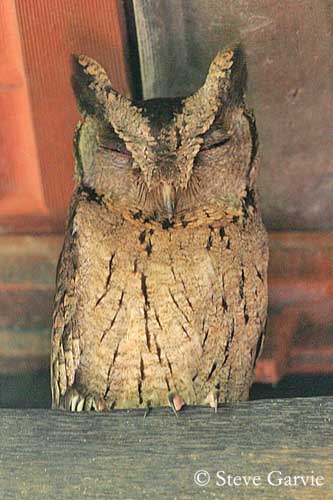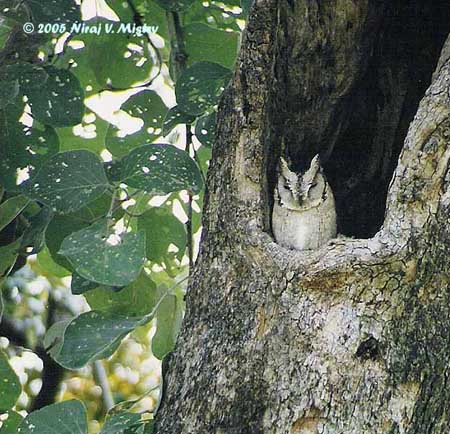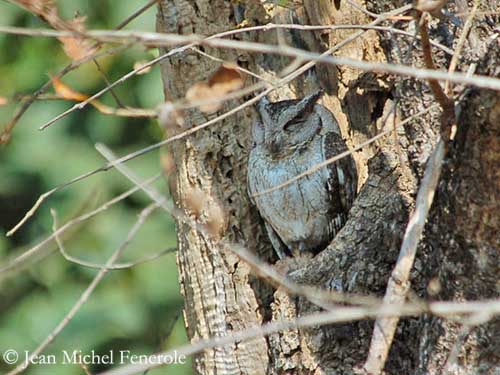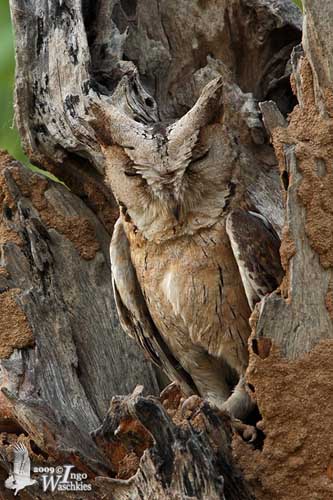
DIET:
The Indian Scops-owl feeds mainly on insects such as beetles and grasshoppers, and several other species too. It also consumes moth larvae. It may take sometimes small vertebrates such as rodents, small birds and lizards, and very rarely bats.
PROTECTION / THREATS / STATUS:
The Indian Scops-owl is widespread and locally common. This species is difficult to find, due to the cryptic plumage when roosting in trees, motionless and silent.
The species is not currently threatened, and evaluated as Least Concern by Birdlife International.
Fr: Petit-duc Indien
All : Indien-Zwergohreule
Esp: Autillo Indio
Ital: Assiolo indiano
Nd: Gekraagde Dwergooruil
Sd: Indisk kragdvärguv
Photographers:
Jean Michel Fenerole
Photos d’Oiseaux du monde
Steve Garvie
RAINBIRDER Photo galleries
Niraj V. Mistry
Photo Galleries
Ingo Waschkies
My bird pictures on Pbase
Text by Nicole Bouglouan
Sources:
HANDBOOK OF THE BIRDS OF THE WORLD Vol 5 by Josep del Hoyo-Andrew Elliott-Jordi Sargatal - Lynx Edicions - ISBN: 8487334253
HANDBOOK OF THE BIRDS OF INDIA AND PAKISTAN – vol 3 – By Salim Ali and Dillon Ripley – OXFORD UNIVERSITY PRESS – ISBN: 195613023
BirdLife International (BirdLife International)
XENO-CANTO – Sharing Birds sounds from around the world
Indian Scops-owl
Otus bakkamoena
Strigiforme Order – Strigidae Family
BIOMETRICS:
Length: 20 cm
Wingspan: M: 61 cm – F: 66 cm
Weight: 125-150 g
DESCRIPTION:
The Indian Scops-owl is now considered as full species. Formerly, six races were included. They have been split up into two species: the Indian Scops-owl and the Collared Scops-owl (Otus lettia).
The Indian Scops-owl is found in India, whereas the Collared Scops-owl occurs in SE Asia.
The species is found in two morphs, greyish-brown and rufous. The rufous morph is usually commoner in southern populations, and shows distinct ochre tinge.
The adult male of nominate race has pale greyish or rufous facial disk bordered black. Forehead, eyebrows and long ear-tufts are much paler. The crown is mottled blackish.
The upperparts are mottled and spotted dark brown to blackish. We can see a pale buff collar on the hindnek, and a second one on the nape. The spots on scapulars are pale buff and indistinct.
The underparts are grey-buff or rufous-buff with fine dark shaft streaks and vermiculations.
The bill is horn-coloured with paler base and lower mandible, and dark tip. The eyes are hazel or brown. The legs are usually feathered to base of toes. The feet are brownish-flesh with horny-brown claws.

O.b. bakkamoena
Rufous morph
Sri Lanka near Tissa
Both sexes are similar, with female slightly larger than male.
The juvenile is pale grey or yellowish-brown according to the morph, and barred overall.
We can find four subspecies which occur also in two morphs:
O.b. bakkamoena occurs in SW and SE India and Sri Lanka.
O.b. gangeticus occurs in NW India to lowland Nepal. This species is slightly larger than nominate and paler too. It is more yellowish-grey than the following race.
O.b. marathae occurs in C India, E to about West Bengal. This race is similar in plumage to nominate, but usually less rufous and greyer overall. It is larger too.
O.b. deserticolor occurs in S Pakistan and possibly SE Iran. This one is a typical desert race and shows very pale plumage with whitish belly and lacks the rufous tinge. The eyes are hazel to yellowish.
VOICE: SOUNDS BY XENO-CANTO
The Indian Scops-owl male gives a quiet, frog-like, interrogative “wuk?” or “whut?”. This sound is uttered in regularly spaced series with pauses between each note. The female has lower-pitched call. We can also hear series of slow bubbling “ackackackack…” on ascending way.
HABITAT:
The Indian Scops-owl frequents forest and secondary woodland, wooded gardens and orchards, groves around villages and cultivated areas. It can be occasionally found in more open country with trees, plains and hills up to 2200 metres of elevation, 1200 metres in India and up to 2400 metres in E Himalayas.
The birds of Pakistan frequent irrigated plantations and riverine forest in the dry areas.
In Sri Lanka, they nest at edges of rubber and tea plantations.
RANGE:
See above in “subspecies”.

O.b. gangeticus
Grey morph
Ranthamnhore National park - Rajasthan State - India
BEHAVIOUR:
The Indian Scops-owl is a nocturnal species. It spends the day hidden in tree holes or on branch in the dense foliage. It takes advantage of its cryptic plumage and it is very difficult to find it. Small passerines often harass it when roosting in tree.
This owl feeds mainly on large insects such as beetles and grasshoppers, and other species too. It also consumes moth larvae. It can occasionally take rodents and small birds, also lizards and rarely bats.
The Indian Scops-owl nests in cavities, often a hole in tree. The nest is maintained clean and the same hole is reused year after year.
The species is resident in most part of the range. Some altitudinal movements are observed in winter, and also some nomadic trips according to the food resources.

O.b. marathae
Grey morph
State of Madhya Pradesh - Kanah- India
FLIGHT:
The Indian Scops-owl, as other Strigidae species, flies silently thanks to the downy feathers’ bases. The flight is deeply undulating.
REPRODUCTION:
The breeding season varies according to the range, but in the southern part, it often occurs during the rainiest season. Usually, the laying takes place between December and May.
The nest is in natural cavity, a hole in tree or in abandoned building near habitations. The nest is usually unlined, and placed between 2 and 7 metres above the ground.
The female lays 3-5 white eggs. The incubation lasts about 27-28 days. Both parents share all the nesting duties. The young fledge about 4-5 weeks after hatching; and they still depend on parents for food during 3-4 weeks more.

O.b. marathae
Rufous morph
Chambal River - C India